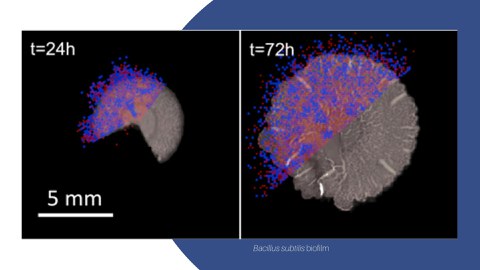How do biofilms heal their wounds?
- Prof Dr Liraz Chai The Hebrew University of Jerusalem, Institute of Chemistry.
- Prof Dr Vasily Zaburdaev Friedrich-Alexander-Universiatät Erlangen-Nürnberg & Max-Planck-Zentrum für Physik und Medizin.
Biofilms are commonly known as complex bacterial communities that encase themselves in self-produced polymeric matrix substances and excel in withstanding various environmental stresses, including antibiotic treatments. They are notorious for causing disease but cultivated to protect symbiotic plants or clean water from contaminants.
These versatile traits become possible because biofilms function as heterogeneous multicellular organisms, sharing capabilities frequently identified with developing eukaryotic organisms and tissues. One such prominent feature in eukaryotic tissues is the ability to recover from mechanical damage and heal wounds. Remarkably, while biofilms in natural environments and in the lab evidently heal their wounds, the mechanisms of wound healing in biofilms are virtually unexplored.
In this project, using the model biofilm forming organism Bacillus subtilis, we will combine experimental microbiological and biophysical approaches with theoretical modelling to understand how biofilms recover from mechanical damage. This process naturally ties together multiple aspects of biofilm existence, such as cell growth and death, metabolism, signalling, cell differentiation, extracellular matrix production, mechanical forces and water fluxes.
Specifically, in the experimental part, we will follow the closure of wounds in biofilms of different ages and mutant backgrounds affecting biofilm composition. We will measure emerging forces, quantify the corresponding changes in mechanical properties of biofilms, and correlate those with the phenotypic composition in the wound.
To address stress responses and signalling that might be involved in wound healing, we will perform experiments with biofilm monolayers. In the theoretical part, we will rationalise the wound closure data in multilayer lattice simulations. We will treat the biofilm as two-component viscoelastic material composed of cells embedded into the polymeric matrix and build a continuum description of the biofilm to capture the roles of forces, water and nutrient fluxes in the wound healing process.
Finally, to link between mechanics and molecular stress response, we will perform agent based simulations of wound closure in biofilm monolayers with explicitly modelled regulatory signalling networks. Uncovering the mechanisms responsible for wound healing will require an interdisciplinary effort involving reciprocal experimental and theoretical tools. This study will greatly advance our understanding of biofilm physiology, and, we believe, it will also shed new light on the healing processes in eukaryotic and artificial tissues.
| Researchers |
| Mnar Ghrayeb (PhD Student) |
| Ricardo Santander Gualdron (PhD Student) |

